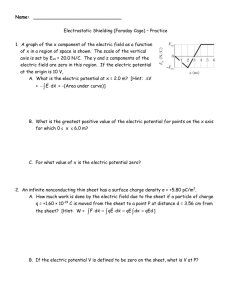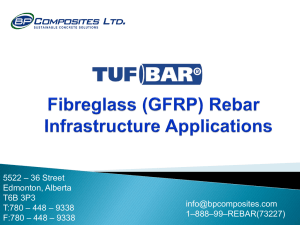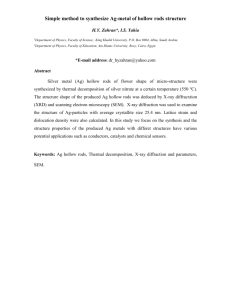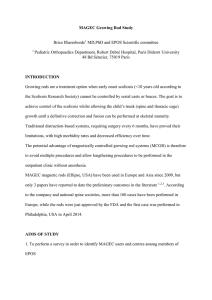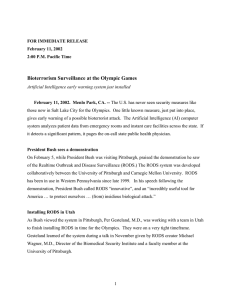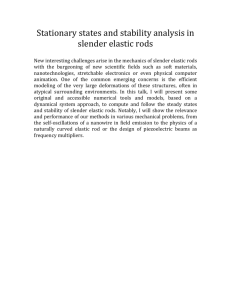CONCRETE LIERARY GE JSCE NO. 29, JUNE 1997
advertisement
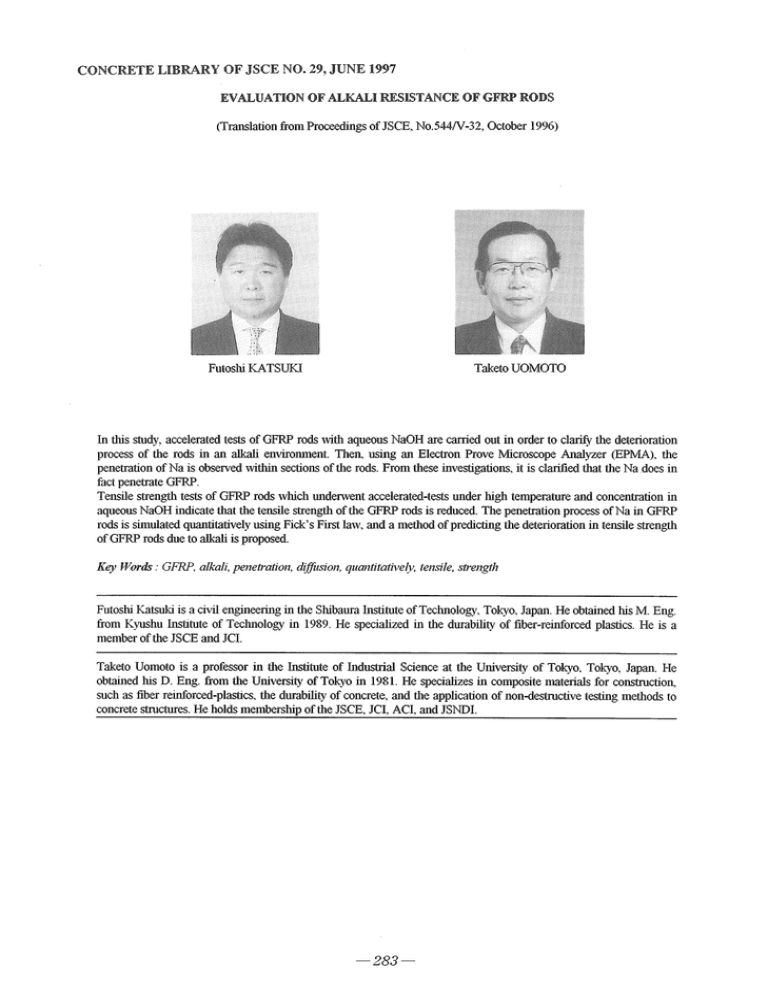
CONCRETE LIERARY GE JSCE NO. 29, JUNE 1997
EVALUATION GF ALKALI RESISTANCE OF GEM RGDS
(‘Translation from Proceedings of JSCE, No.54-4/V-32, October 1996)
/
‘-
-1 5'11 -I I " ‘
-1- -
.5.-:1-11.5%
.1 J
k
y _ _ __ _
.1
i
i
1
_ , ,
‘-9.1<:i§II»‘I:~EIE-'1-I
'1 ;jl—I"<*/1" " '- ‘_‘,~;£~f1j~:v“f-;=l-, :1
:-':-f<-;-<-s‘e::1n-iv!‘-->»'<:
-111='i:111-‘s-1:11-1z:;I:¢/24'1<:1:>é:1'J;€r1r=:*=:» ;==
»~
1-
=
-1 ~ ,1.<
/.
-»-
1* __ _ ~
1‘ _‘ 1
.
1; 1 . - -.-1 -1 '' ' .
=‘~<-1»I~}_~11_‘—j-j1'—I_~j 1' _ _. ._ . 1.
.- -.
- -
..'<11-.==:=;=:'.4:=>~(4§<1-;<-1<111;-;-.1.'. .»
,
-=
/
sit_.
.
/
112131
:-;'-1"‘;
’
111I:I-T-L- ~§=.l,-.~2,- »
'1 ;1_ —
1/111'" Vi‘? 1-5‘.-5}.‘
f~5>'I>t!;~$<1C>i€.
(1 .
r.=.-‘:11r111=11;=-
I
-
---.,~.-11.-.~ Y.-.~.<.-_».;1.
:¢=11»:=1»::e=¢:z=,=-4s1;:;az=§:==:%:‘?:=és
z;:::1;:=1z:a>::::2.r<1==-1--~1--1"~11:-as111:»1&12=s::<>$@
"'1-':s-::1.:.-~=a=s:>-r
_
1 1:1==,:?:1=1_;-1=-'.~.-<-,;;1;<>?§2;:=:1:5§
-111==s:>s1;=s1e::::I:2=;anz1.¢==z12:=1==z_>==s-':"1~ :1»-1.-.:~/1:12
*:-E>.1Si-I
=1;:§:-_:gz1:5;{:5:5:;:§:§3;§:n§;1;;;1;:11j1j1g;*l;-j¢;.;;1;¥_:;1:1>"E.
:_1:§:§-.§.§:l:§:1'1.I;1:~'=}.<2255*>§<:21:1;i:f-1.11.11-.11,-1";:;:,;:;;§'E:,:'; .
:-1<:-1<:¢:l:;I§:§:;I:t1;l;- 4;-.;11';:1::;:::; ;.1.-;-§.—:-u:-2»
- ;:1:11.§.-1--5IE?‘-I"I‘1‘£‘ZI:i:1:§:f$§.-$QY:1:;;§1-'1'.
1 1 ;1I:I;~2:.1. 1: »: I»:-1=:;<>;1:1;’<%£¢-:I;'.'_
<
i
-~-‘»‘=--‘/Q» rm '. -' 1 -1.
_- »
-9' -w1‘P\‘>\t’<1~\*
15'I’ it 1»I;1»"'-I;I;1_1L;I
E§';i;3‘<:!;IL;-1;?‘ ;:—'». ;.;. _ _
-\- |<_»~--V ‘,-'
. ~ 1-2-'a -‘ _»:-'-'4-L:-1‘:. t- ,1»~
-w»-z;-.1 <.€z1:.1.=(-.-1-'1
'1*1-?I4-$1-I-i>I{>i~I1J'<I€§ ,»,r~
1v;1§-;-;.;»,;/ .;/_'_.;/11;.» : '
.
j?;:':1:1»“ .-‘
~ -1--1»;-—
» */,»_~’
,-/
;= ~’ “,»’;1»:;1’
_
> p
I
léetiisis
==1;:2<>:1;:=:;:;:1;§I1;2»
§1:;:.1.1My
' >',»>':=1»:§Z4:27;§?-)1E;i
:1-:=-2=1-1:21-:=1;-;;i:>;s_a=;
:1.-.11.-.- ;._-1. -1 '1-->1;:z=~+:-<1<;:::>:
;&~€:¢:§5:;i:5:1:¢:5:1;15:',-55,:-.;;,;:;-13.;z;
1-£1512:E:?rE:1=£:-:;
:1:~:1:1:!:1;%I5;1i
;;_32;.;1;;;11.,;
1»;;».g .1;
1;‘; 5.;;1;1<;:1:;:;g:;r;-1-;;:;:;:_:;'
;>_:;:;2;;;;:;;~'_:;1_q:;.;:;.4_
<;:4»g>z;1;a--25-11;-;;;:-1;:g;;;;.__,.;1
.
;;;:;:;;:;:;;g;:;;;:;;;:;;;;;-:-:;;;g:;g;;1;;:;;;;_:_
~:-:-;~fi:1:1:1;~;-x1'.1:c~;~;<,l' ~:-:->-241' "'
’-';<Z-I-5?“-E2i:I~li:I~2-§f~JI1$».<1<I1;;<».—&2'£1<§;1;-i-;2;2:;:;:;1;1:;r5;:;I§;(;§2§;-;§g;:;r;:;§ ‘fii$§§i:;:.-j.‘:1§=_»;-;fg:1z?:-i1121?:i:I:fLi;I<-2:111:12?§:T:§':1;1:?:I1
5:5:§$§:f:;j2g:{:[§:§yi:5;1<53:21112112&f§ZI;:g:;E;.;,;;:;:; -;.;,»:;:,;:j;:g§3:;:§:}:;§:§:§1[:§:f:§:j;§1§;~j:§§:71;1:;:{:;:§::{:1;:
14+;;-1-;-1-1-4%:-s-1:1-:¢:21:r1=:=1-Wmrw=11; 1:.1-.>4;;--->.-1-1-1-:-1-1-:-1-:-:41-»;,1§:§£:}:f:§:§;;'.j:§:§:f>‘ Inf;-g:§;§:;;':f:%:;-.311E§1;‘:§'§I-1 I {1} :§:j-?:/I‘/fvfiji"5:1;;;(;§.l.§.§1;;§:;;;:j;§§Y§:;jE§:3;§2.{1§.§.
A
-:—:<—;-:-:-;—;—:<-1-1-:-1-:r-:-r4-1-:-:=1--.1-1'~1>1--:11-:1;'1r=:1<1;-:-:c—:-1»:-11;-;-11-1
¢;1:;:¢;:;:;:-:;:-/ *3:-:_1-;;-1-;-,4-::-: -":-‘.-;I,I1:l;¢;=2=:-:=:- '-is;i;:;1;iQi;:;‘;:;1~:1:;:;:1:-1-1-:::;;;:-;-;;,
<;»I11511:l~54'
.‘1;5i3:i:-5:-/:-:-:-:3:-:3'3¢:>Z;i:T-‘. - 1’-:=<:I;I-4'-I-1-"1111s-'1>1>-4/1‘
‘111:-2;-:~l1::1:1:<:1:%-t~'<1:1::-1:5».-.11:--1-‘ 1 1-‘
)3? 155%3Z-?5’
F»:-1/ta-,»-:-:-:-.-::-;~:-;~:-51-s1‘-.
’",‘i ?€"1I>-'PEI5-'<'~’1'I’-"- ,;:;¥;:;;3:{>j11,:~211¢:i
1<;11>1<
1:11;
4&:i<§:3r_.;;.='l.:1
F11» j;-;1r=1:;1:‘:I:‘.'»:i:"".
-. -..
1"
a‘.;;;=:I.1<=- ' .
3 11 '1 -- .---=1, ' . 3'11=;1:‘1'»-'= -21*-=&z:
r§§»4:>:i.~ =.:s
- .:
11 -1' 1.' .- I 1
' .111 I11 -1- .; -. . . 1» : ’»t.'-;l1.1i1ii
=’;:~:-I-11;r11;»;1 ~*l~:-I-1;11;1:1:I$:-:3»1
:?.»;-i:;;;,;f;Z&i;1\_ . 1' . I ' -1-1' "
1- -1 .. -. :1‘
-=1-1-1-1;-..~'1‘1'-“=11;i;11!-I;1:1;?*'.-11:‘.
</_';' 1 ,; -1 -1 ~ _
' 1' .-1 11- ; j.j.1§ j:§§:§:(§"‘;1
_' .- 1-1 1- 1- - ._ _. _; 1;‘:IJ.=-11151f.j1‘zf:‘;j:;t5:5;:;r;t:;!:;:I:I;:~L;:g;:>-._. 1 ~ 1~
1:1
1
'-'
1
~
' 1' 1' 1' 1 . _ 11%;;-1_F;=1~_=;.=§=‘§-:-59:11;1I;{:;I;1;I;Tf§i ' ‘\
' . ' 2"
,_
1
-1 1- -1 .- 1>~
. - .. 11
.‘
.=: '=:1:115.1:1&:E-1---111-1‘;-;I.1;i;1;I:13:I:1?§ ~ ‘$41 -‘:1. -'.1¢~: *
' \ '1-1 .- 1.'1 -'
1:
"-I11-1--'
41;-L: :?;I:“1"$:?5'1:T"$§’
4;‘ > ~ 1F -1: -R~
-‘-11-'11--'11>1:1*---1-:1;¥+:-:-'
<§4§1-F41
1‘.i:°'1<':"-=~.- '-:1’ ' 1'
'-""5"1**35=i=?‘5$?§=£§€5§3?""
‘~11
.<‘:'=:3-.;:1.4
._- I ' '' ."T-=5I=1 :-.11;='11 1 1 1 111 1'2E¢i
ré;f_:¢
I.
_,
.1111-111:1:-:1
. "
. >
.1.-1 11,w.-111'»:-';t-5
;.:--=1;:;.e<:<--1'. :11-::";="--_-;, ‘
1-:11»
-=
1
i-I‘~>~E-L93“:1"-1">11€I1‘>:-1»5&1.11515-‘L
."
-“'=<»-'2-:2""1=1its:§2:;:a:>a -11%;;-1 ;-;1; :;
11> , 111:
1‘ 1 -%=i~~1
-" .1 1E'I:j1r_-I-;‘~1Er'-E1‘rEI:1:1:;:{:§s3;:{:1155151311
-
‘==&11.:2>=1-211‘-‘%=-‘:2-11':1-fl? I:'-- :% :1 1?‘.
-:.;.;-:-.-:=
,/r;,,,-_-»»'>i"
:;';e:-<;.»;;-I '
;;“'11:':1:'~:=:5.‘:Z .4$“";?5‘1’1?%'$i~‘311=:!11- 1' 1'
1-1111‘15:'-1.I:‘.~':
-
/
/
»/
:-:=~:>l-.~>»,-=-- ¢
'-‘:‘?:';\\:‘-':‘~‘I<')i‘§d'v}E:v:'
:1;-‘
‘:1'>1:§:1:§i?:I:1'?-:l:-r=:=:¢:-are
‘ -11'-I-‘.1-I’
I-jr»§1'.—f11'l’— "'i1"i‘Z'1*"I‘2"=*.5i\<Z1‘4‘Z'?.I-'
'1-11;:
-311‘:- I-I’.
,
/
,2
I;-5 _ ' 3
-~
\
//
/
-6 -1:( >115; 1 1 1 1 ":‘
1 = 1- "'-'--'=="
.~.1;=:=.-'=:1:1'=:=:Y:1:d;1I=11§1;I:I:1s:=:¥:$i1:'s¥$:= ' '
' 1 111:?
' 11 1
- 1
1;
-- 1 r1111-1?
.- 1
;.‘<,
I 1 *1 1.1?»-1 1 11 11 1»‘11.;‘1-$<¥:.1-1~5::¥11"-t:-1-=;:-111-'1>=:<:>;:=:=-=.:;i§:1-:=1==11==ase
:Er1i1:1:1
{\{>:<;51;;:;ql;I<;t;.;¢.{i;qg§;-pi
\
.1;;.¢.;4.;,;.>;s_.;-_-1-_-»:pa;n~.-.;.@.;.;4.¢¢1;¢
-.11 ,, -,_ @111
_~1,
,1 :-:~f<-1~!~13¢»21:::1:;1.1.:-:42-:-:~;fit-zc-ta
:_;~:-t-.~;-.».,.1.~:-.~.-11.1.1;1-s;.;.;
:‘~:»$;:;:gge<131%$15§:~:€:<§;i;:;.;§<;¢:-2-;%
‘ , 1-; ;.,;1 :- 1
' - 1.. :;=¢1:§1§-;:l:1:'c>!»;~:~#e*.1ie=:1=1:->:r:=:¢:11a:f:=:=1
I~%I:<:=*l:1-.5“; : 1 -1 1$§§,1 .-i:-s;1:=:-t3:eiet?:’r%%:l:$:1:f£:#:§*;s;*;r§1
-_ -_ ;,%>s, - - 1
1:‘-:ii1:-‘1=‘-'-fin‘1?q11;1If-=:n-3;-:t>:E1.-i;$i;:§=51 1__ 1: _.§- _ 11 5111;;§;=i;51$'%1-!§~!r1'5G€'lmjme@577;J~i{§‘Y;T
r;:;'_
_ ~%;; 1 11 -»-11111:»--11:1-1;;5-;1--2*-"g;;:;:¢1¢;>r¢s1.¢:;:::;
.1:-1-.-.;'
.< *° , 1- 1 i:F;?*3i‘l§51'i'?11'1E?1%7:3:§55513511Iérfqbiffi.-6i¥s;I§
"
1-;:-1-:-:-:;:=:-1ram:-=11-1c-as:»:-;~:4-12-11:-;-=-;-$1
.-1~1::1~1»:=:=-are-er;-:i=-F;-:-:=1-1-::,t:=2r:-1?
f-,-;-;~::i_t;.:qi;_fi|'|~\~¢_1- 1' 1'"~ ..‘A.
.
1» /‘~’-'=--‘—’~=
..4..
-1--1---»:-1-.-as.»-<.~
/1='-‘1'-‘=*-’-‘-'~=-*—*
Futoshi KATSUKI
Taketo UOMOTO
In this study, accelerated tests of GFRP rods with aqueous NaOH are carried out in order to clarify the deterioration
process of the rods in an alkali environment. Then. using an Electron Prove Mcroscope Analyzer (EPMA), the
penetration of Na is observed within sections of the rods. From these investigations, it is clarified that the Na does in
fact penetrate GFRP.
Tensile strength tests of GFRP rods which underwent accelerated-tests tnider high temperature and concentration in
aqueous NaOH indicate that the tensile strength of the GFRP rods is reduced. The penetration process ofNa in GFRP
rods is simulated quantitatively using Fick’s First law, and a method of predicting the deterioration in tensile strength
of GFRP rods due to alkali is proposed.
Kev Words : GFRP, alkali, penetration, dzfi’usi0n_, quantitatively, tensile, strength
Futoshi Katsuki is a civil engineering in the Shibaura Institute of Technology, Tokyo. Japan. He obtained his M. Eng.
from Kyushu Institute of Teclmology in 1989. He specialized in the durability of fiber-reinforced plastics. He is a
member of the JSCE and JCI.
Taketo Uoinoto is a professor in the Institute of Industrial Science at the University of Tokyo, Tokyo, Japan. He
obtained his D. Eng. from the University of Tokyo in 1981. He specializes in composite materials for eonstiuction,
such as fiber reinforced.-plastics, the durability of concrete, and the application of non-destructive testing methods to
concrete stiuctures. Hep holds membership of the JSC-E, JCI, ACI,_andplSNDI.
—283—
1
. INTRODUCTION
Glass Fiber Reinforced Plastics (GFRP) are expected to be used as concrete reinforcing materials since they can
significantly improve the durability of concrete structures but do not suffersalt corrosion like steel. However,GFRP
rods are not guaranteed to always act as semi-permanentstructural materials, deterioration of the mechanical
properties of GFRP rods maybe caused by chemical factors such as alkalis.
There are two chemical factors that mayaffect GFRP rods according to the conditions of use. One is where GFRP
rods embedded in concrete are exposed to a high-alkali environment for a long period. In the case of concrete
structures in wet conditions, such as marine structures, the water content of the concrete increases and the alkaline
concentration in the concrete becomes particularly high by dissociation of hydroxide. This causes environment to
deteriorate. The other case is when exposure conditions such as out-cable are affected by acid rain or car exhaust.
Thus it is necessary to clarify the resistance of GFRP rods to chemical attack under the consideration that they maybe
affected by alkali and acid.
Various studies of the alkali resistance of GFRProds have reported that their the mechanical properties deteriorate in
the presence of an alkaline solution [1]. However,the amountof data was insufficient to report on the mechanismof
deterioration of GFRP rods or to discuss methods of evaluating its progress quantitatively!!]. That is, there is an
inability to predict the alkali deterioration of GFRProds in the actual environment fromthe results of accelerated tests.
The authors have nowtheir attention the glass fiber used in GFRP rods, and clarified the deterioration of these fibers
due to alkali[2]. The authors initially assume that the poor alkali resistance of glass fibers result in the reduced
mechanical properties of GFRP rods in the presence of alkalis, although it has generally been assumed that there is
little possibility of fiber deterioration because they are protected by resin.
Thus, the objective of this research is to clarify the causes of tensile strength loss of GFRP rods due to alkali. The
following investigations werecarried out:
1) Sections of GFRP rods wereobserved using EPMAin order to clarify the penetration of alkali in the rods after
accelerated exposure.
2) The condition of glass fibers in the rods after accelerated exposure wasobserved using a Scanning Election
Microscope (SEM).
3) The penetration of alkali in GFRP rods was simulated quantitatively by a model proposed on the basis of a
diffusion controlled theory.
2
. EXPERIMENTAL
PROCEDURE
Fig. l shows the experimental arrangement of GFRP rods immersed in alkaline solution[3]. The dimensions of the
equipment are 10 X 10 X20cm and it can accommodatetwenty rods. The equipment is made of acrylic plate and is
kept air-tight by closing with silicon the holes used to pour in the alkaline solution and insert the GFRP rods. The
20cm-long section of the GFRP rods immersed in the alkaline solution is the portion subjected to tensile tests ; the
anchorages are not affected by the alkali.
Fig.l
Accelerated tests on GFRProds
284 -
Table 1 lists the material properties and the condition of the accelerated tests on GFRP rods. The tensile strength
values indicated in the table are the results of averaging a hundred tests by NISHIMURA[3]. For the immersion test,
it is realistic to use the alkali-ions existing in concrete and the same alkaline concentration as in concrete(=0.05N).
But for this study, Aqueous NaOH(=1.0N) was used as the alkaline solution so as to accelerate the degradation of
GFRP rods. The GFRP rods contained T-glass fibers. Vinyl resin was used for the matrix in consideration of
elongation of the T-glass fibers. Table 2 lists the chemical compositions of the T-glass fibers and Table 3 lists the Tglass fibers and the matrix.
Afterthe immersion tests, the rods are washed with distilled water and dried for 24 hours in a dessicator.
Tensile tests on the GFRP rods were carried out according to the method specified for continuous fiber reinforcement
(JSCE). Split chucks developed by KOBAYASHIwere used as the anchoring method in the tests[5]. A protective
coating was added to the anchorage surface by first applying unsaturated polyester resin as a bedding treatment and
then a uniform coaling of a mixture ofunsaturated polyester resin and iron powder (300 mesh) with a weight ratio of
1 : 1.8. Tensile tests were carried out at a temperature of20±5°C. TwentyGFRProds weretested for each case, with
the cross-head speed maintained at 5.0 mm/min.
Table 1 Characteristics of GFRP rods and conditions of accelerated tests
F ib e r T y p e
M atrix T y p e
D ia m eter (m m )
S tre n g th (M P a )
T -g la ss
v in y l re sin
6 .0
16 4 0
A
C
T
C
lk a lin e s olu tion
o n ce n tra tio n (m ol/l)
em p e ratu re ( C )
u rin g tim e (d ay )
N aO H
1 .0
40 ,60
7 , 3 0 , 6 0 , 9 0 , 12 0
Table 2 Chemical compositions of T-glass fibers
ig .lo ss
S iO 2
A 12O 3
F e oO a
C aO
M gO
N a 20
0 .8
6 5 .1
2 3 .9
0 .10 8
0 .2 9 6
9 .7 4
0 .0 8 4
Table 3 Material properties of T-glass fibers and matrix
T -g las s fi b er
V in y l re sin
T e n sile stren g th (M P a )
2 5 10
86
3
. INFLUENCE OF ALKALI ON GFRP RODS
3
.1 EPMA Observations
Y an g s m o d u lu s (M P a )
8 5 5 10
3300
S tr ain (% )
5 .1
Fig.2 shows the penetration ofNa into the sections of GFRP rods observed using EPMAafter immersion times of 0, 7,
30, and 120 days. The black areas are those affected by Na due to penetration. These results show that hardly any Na
existed in the rods before immersion ; that is, Na was not detected in the rod section at all. On the other hand, Na was
detected in the rods immersed in aqueous NaOH.This demonstrates that the Na observed by EPMAhad penetrated
from the outside. It also clarifies that Na penetrates into the rods centripetally with time. Thus, it is demonstrated that
resin cannot completely protect the glass fibers from alkali attack.
3.2 SEM observation
Fig.3 shows the condition of glass fibers in an area where EPMAshowedNa to be present. Sections of glass fiber
before immersion are smoothly circular, while in the Na penetrated area they were corroded by the alkali. It appeared
mat the bond between fiber and matrix had failed, and this was assumed to be the cause of reduced mechanical
properties in GFRP rods immersed in alkali solution.
3. 3 Alkali penetration
As noted, the alkali was seemed to penetrate into GFRP rods. The question of howthe alkali penetrates into GFRP
rods appeared interesting, so the authors measured Na levels in sections of AFRP and CFRP immersed into alkali
solution to confirm whether alkali could penetrate into rods with other types of fiber. The same method wasused.
Fig.4 shows the results for AFRPand CFRP rods immersed for 60 days in 2.0N aqueous NaOH.The matrix wasthe
samevinyl resin as used for GFRP rods. Results showed that, in spite of the alkaline concentration being twice as
285 -
high as that in the case of GFRP rods, Na was hardly detected in the rod sections. However, there was same
distribution of Na near the surface of AFRP rods. If alkali penetration is assumed to be caused by poor alkali
resistance of the fibers, and given that the alkali resistance of aramid fibers is somewhat inferior to that of carbon
fibers, Na might be expected near the surface of AFRP rods. Thus alkali penetration into FRP rods is dominated by
the alkali resistance of the fibers in the rods. In order to grasp the progress of deterioration of glass fibers in GFRP
rods, the distribution of Na in a rod was observed with a microscope. Fig.5 (a), (b) show the results of analyzing Na
and Al ; these are enlargements of the area in which Na wasdetected in the section of the GFRP rod. Fig.5 (c) shows
the condition of glass fibers in the samewhere Naand Al were observed. Results confirmed that glass fibers within
this rod were corroded as shownearlier in Fig.3. This corrosion can be also be deduced from the Al count near the
surface of the glass fiber, which is higher than in the center.
(before immersion)
(immersion times of 30 days)
(immersion times of 7days)
(immersion times of 120 days)
Fig.2 Na analysis of immersed GFRP rod section
Fig.3 Condition of glass fibers in Na-penetrated area ( X 3000)
28
(a) AFRP
(b) CFRP
Fig.4 Na analysis of immersed AFRP and CFRP rod section
( a)
(b) Na analysis
Al analysis
(c) SEM
Fig.5 EPMAanalysis of deteriorated area of immersed GFRP rods
This indicates deterioration resulting frombroken molecular chains in that Al detached fromglass fibers. Fig.5 (b)
shows that a lot of Na was detected in parts of the glass fibers deteriorated due to alkali, while hardly and Na was
detected in the matrix. That is, glass fibers were corroded at the interface between fiber and matrix while deterioration
of glass fibers did not progress inside the fibers. Therefore, it was seemedthat 'Na' penetrated into GFRP rod through
the layer that had high diffusive capacity ; namely, the part of deterioration took place on the interface between fiber
and matrix.
It is known that silica-oxygen-silica bonds in glass fibers can be broken by hydroxyl attack. Given that glass fibers in
-287-
GFRProds deteriorate due to the presence of an alkali, it can be concluded that the fibers are corroded by hydroxyl
penetrating fromoutside. But hydroxyi could not be observed by EPMA.Thenthe authors assumedthat hydroxyl and
Napenetrated in the rod simultaneously in consideration of chemical attraction between a positive ion and a negative
ion, so it was equally evaluated to replace the penetration of hydroxyl by the penetration of Na. In this paper,
assuming that the area ofNa and hydroxyl penetrated into GFRP rod wasthe same,this paper defined this area as the
layer that glass fibers in the rod wascorroded by hydroxyl.
3.4 Influence of temperature on alkali penetrationl
Fig.6 (a), (b) show the penetration ofNa into the section of GFRP rods accelerated at 40°C and 60°C, respectively.
The Na-affected area in the rod immersed at 60°C for sixty days and at 40UC for a hundred twenty days was almost
the same.This indicates that the penetration rate of Na is directly proportional to temperature. That is to say, it is
confirmedthat temperature affects the penetration rate of Na.
(a) immersion at 40°C for 120 days
(b) immersion at 60°C for 60days
Fig.6 Influence of temperature on penetration speed
4. RESULTS OF TENSILE TEST
Results of tensile tests on GFRP rods including the standard deviation, are given in Table 4. Each tensile strength
value is the result of averaging the twenty test data in the table. Results show that the tensile strength of GFRP rods
falls whenthey are immersed in aqueous NaOH.
Table 4 Results of tensile tests
T em p .
4 (T C
6 0 -c
im m e r s io n tim e s ( d a y )
7
30
te n s il e s tr e n g th (M P a )
1260
9 10
S .D . (M P a )
82
60
15 7
te n s il e s t r e n g th (M P a )
664
577
S .D . (M P a )
88
5 1
Fig.7 Fracture pattern of immersed GFRP rods
-288-
90
120
56 0
4 80
16 3
94
Fig.7 shows the nature of GFRP rod fractures offer immersion at 40°C in l.ON aqueous NaOHfor 90 days. Fig.8
shows the load-displacement curve for the failure of a GFRP rod. Twokinds of time immersed penetration ofNa, law
(A) and high (B), are shown in this Fig.. In both load-displacement curves, the load falls once at a lower load level,
then increases until the breaking point. The falling point of the load at a lower load level is decreased with increasing
Na penetration, so it was seemed to be caused by the damage of the penetration area was large as long as time
immersed.Therefore, by finding out that the falling point of the load at a lower load level certainly happened before
the breaking of rod, it was assumed that deteriorated area wasnot undergone the tensile load at the failure strength.
It is observed that the fracture pattern near the surface differs from that around the inner part of the GFRP rod in
Fig.7. That is to say, it seems that failure occurred near the surface at a lower load where glass fibers had suffered
deterioration due to alkali penetration, whereas the fracture pattern of the inner part was broom-hike, similar to the
fracture pattern of GFRP rods before immersion.
Fromthe results of EPMA analysis and the failure state of GFRP rods after accelerated deterioration in aqueous
NaOH,it can be assumed that the fall of load at lower step occurs by breaking on the penetrated area in GFRP rod ;
namely, glass fibers within the alkali-penetrated area have suffered deterioration due to alkali, and failure of these
fibers is antecedent to the failure of glass fibers in non-alkali penetrated areas.
Consequently, failure strength can be evaluated by measuringthe non-alkali penetrated area within a GFRP rod.
B
reaking of the part
of no alkali penetration N
Breaking of the part
of alkali penetration
L
oad
Displacement
Fig.8 Load-displacement curve of GFRP rods after accelerated test
5
. METHOD OF PREDICTION
In this chapter, a method of predicting the loss in tensile strength of GFRP rods immersed in alkali solution is
proposed.
Degradation of GFRP rods was modeled on the basis of results obtained from EPMA analysis and tensile strength
tests. The authors assume that failure strength can be obtained by measuring the non-alkali-penetrated area within
GFRProds ; namely, the tensile strength of alkali-penetrated
areas can be assumed to be zero. If the extent of alkali
penetration into GFRP rods can be predicted with time., it will then be possible to quantitatively predict the tensile
strength of degraded GFRP rods. Thus, the authors tried to predict alkali penetration into GFRP rods using Pick's
first law, as given in the form shown by Equation (1). Fig.9 shows a simple model for predicting alkali penetration. In
order to apply Equation(l), the measured alkali-penetrated
area is treated a circle in this model. The diffusion
coefficient of alkali in GFRP rods wascalculated from the depth of alkali penetration in Fig.7 and Equation( l ). Hence,
diffusion coefficients at 40°C and 60°C are as 2.8 X 10'6(cm2/hr) and 7.5 X 10'6(cm2/hr), respectively.
x=V2-k-C-t
(1)
-289-
where x, C, t indicate depth from surface of the rod (cm), alkaline concentration (mol/1), and curing time (hours),
respectively. Also, k is the diffusion coefficient (cm2/hr) of alkali in the rod.
Then, the formula to calculate immersed GFRP strength at a certain age is derived under the following assumptions:
1) Failure strength is decided by measuring the non-Na-penetrated area within the immersed GFRP rods; namely,
the tensile strength of the penetrated area is zero.
2) The strength of the non-alkali-penetrated area is the same as that of GFRP rods before immersion.
Fromassumptions 1) and 2),
a -3L-*L
\jr\
-
-
<?D0
/.
<sDt
Pt=St-a0
(2)
where a0 and at mdicate tensUe strengm before mimersion and at a certam age (>ff
P0 and Pt
indicate failure load before immersion and at certain age (kN), respectively. S0 and St indicate the sectional area of
the rod and the non-Na-penetrated area within the immersed rod, respectively.
Fig.9 Converting to simple model for predicting alkali penetration
1800
A 60°C
Experiment
1350
t
900
450
60°C- C alculation
30
60
90
Curing time (day)
Fig. 10 Results oftensile
Therefore, the tensile strength of an immersed GFRProd is
a,=-'°
Sr
Pt
= <Jr
s
t
-290-
tests
120
rc-(R0
=ar
-xX
(3)
7C-R
if we substitute
Equation (1) into Equation (3), Equation (4) results as.
(.
°t
V2.k-C.tf
= 1
v
p
K-O
/
-CTO
(4)
where R0 indicates the radius of the GFRP rod (=3 mm)
The strength loss of GFRP rods in accelerated tests at 40°C and 60°C with l.ON aqueous NaOHis illustrated in Fig.
10. Here, the calculated value is obtained by using the diffusion coefficients k40=2.8 X10"6(cm2/hr) and k60=7.5 X 10"
6(cm2/hrs) and alkaline concentration l.ON. The results of the simulation match well with the experimental results.
This confirms that the strength loss of degraded GFRP rods due to alkali can be predicted using this calculation
method.
6
. PREDICTION
OF DETERIORATION
FOR A LONG TERM
E
It was explained in Section 4 that temperature affects the speed of Na penetration. Experiments showed that the
temperature effect is a variation in diffusion coefficient corresponding to temperature change, with a relation that can
be expressed by the following Arrhenius equation:
I og10k
(5)
+log10F
=
R -T
where, F, E, and T indicate frequency factor, activation energy, and absolute temperature, respectively.
Table 5 Prediction of deterioration of GFRP rods in concrete
im m e r s io n ti m e s ( y e a r )
s t r e n g th l o s s ( % )
3
6
9
15
3 0 .0
4 0 .8
4 8 .6
5 9 .7
-4.5
-5
6J3
o
-5.5
k
-6
=9.1
20 °C
X 10-7cm2/hrs
-6.5
2 .9
3 .1
3.2
3 .3
3 .4
3 .5
1/T*103
Fig. 1 1 Arrhenius plots
Diffusion coefficients calculated in Section 5 at 40°C and 60°C using Equation (5) are illustrated in Fig.1 1. The
diffusion coefficient calculated on the basis of two experimental data of them and Equation(5) is 9. 1 X 10~7(cm2/hr) at
20°C.
Table 5 lists the results of predicted strength loss of GFRP rods using Equation (4) for a long term based on the
following assumptions :
1) Diffusion coefficientsdo not vary with alkaline concentration.
2)
Alkaline concentration in concrete is fixed at 0.05N (pH=12.7).
The results of this calculation could not be checked against measured data due to the non-availability of long-term
-291 -
data. However,it is possible to predict that the tensile strength of GFRP rods in concrete will decrease about 60% over
15 years.
7
. CONCLUSION
The objective of this research was to clarify the cause oftensile strength loss in GFRP rod due to alkali, and to predict
quantitatively the strength loss. The conclusions drawn
fromthe research are as follows.
1) From the results of measured Na in the sections ofGFRP rods immersed in aqueous NaOHusing EPMA,it was
confirmed that Na penetrated into the rods.
2) At the same time as alkali corroded the interface between glass fibers and matrix , it also penetrated the GFRP
rods. This phenomenon happened due to the poor alkali resistance of glass fibers in the rod. Therefore, no Na
penetrationoccurs in AFRP and CFRP rods, which include aramid and carbon fibers with high alkali resistance.
3) Alkali corroded glass fibers in GFRP rods, leading to tensile strength loss of the rod.
4) Temperature affected the speed ofNa penetrationin GFRP rods similar to that in glass fibers.
5) Failure of GFRP rods immersed in alkali solution occurs within the alkali-penetrated area before failure in the
non-alkali-penetrated area.
6) A simple model is proposed in which the alkali penetration process in GFRP rods is simulated quantitatively by
replacing alkali-penetration with a problem of diffusion. The decrease in tensile strength of GFRP rods due to
alkali can be accurately estimated using the proposed model.
References
1)
2)
3)
4).
5)
JSCE: The Way of Thinking on Durability in Continues Fiber Reinforcing Materials, Concrete library 72,
1992.4 (in Japanese)
Uomoto and Katsuki: Fundamental Study on Evaluation Method for Alkali-resistance of Fibers, Proceedings of
JSCE, No.490/V-23, ppl67-pp!74,
1994.5 (in Japanese)
Katsuki and Uomoto: Experimental Method for Alkali-resistance
of FRP Rods, Seiken Leaflet, No.242 , 1994
(in Japanese)
Uomoto and Nishimura: Properties of Fiber-Reinforced Plastic Rods for Prestressing Tendons of Concrete ( 1),
Seisan-Kenkyu, No.5/Vol.42, 1 994.5 (in Japanese)
Kobayashi: Anchors for fiber-reinforced plastic tendons for prestressed concrete, Seiken Leaflet, No.158, 1987
(in Japanese)
-292 -
